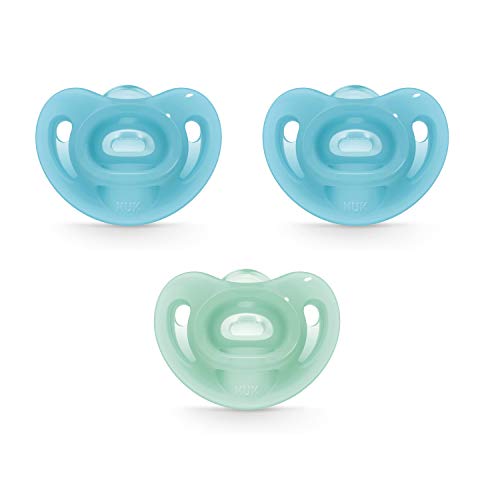So, you have been in the hospital for the first week of your baby’s life, your pregnancy is finally done, and you can breathe easy now that everything is okay.
Over the following few weeks, though, new questions start going through your mind. You see that your baby has an innate need to suckle, but you and your breast need a bit of a breather from time to time.
You start wondering if you should be getting a pacifier, but is now the time to do so?
Is it okay for a baby to be switching so early, or what even is considered old enough for a baby to start using a pacifier?
Will the baby get confused between it and the real thing?
In my honest opinion, the best pacifier for a breastfed baby is one that will not confuse the little one and will keep them happy after switching.
But how will you know what works for your child? How will you know what to look for and what to avoid?
Well, not to worry, I am here to help answer all of your questions.
The 8 best pacifiers for transitioning breastfed babies
Before you figure out the number of pacifiers you need for your baby, you should identify one or two brands that stand out as the best to you. Below, you’ll find out what my favorites are!
1. Nuk Sensitive Orthodontic Pacifiers
- 100 Percent silicone design smoothly contours to babys face, preventing marks on their sensitive skin
- Heart-shaped shield fits perfectly under babys nose for easy breathing
- Bpa Free; Medical grade silicone nipples; top-rack dishwasher safe
- Made of medical grade silicone
Prices pulled from the Amazon Product Advertising API on:
Product prices and availability are accurate as of the date/time indicated and are subject to change. Any price and availability information displayed on [relevant Amazon Site(s), as applicable] at the time of purchase will apply to the purchase of this product.
First on my list is a simple, but effective product from one of America’s favorites, Nuk.
It is a BPA-free, one-piece pacifier designed with maximum comfort in mind, making it ideal for breastfed babies as it doesn’t expose them to any dangerous chemical compounds or present a choking hazard.
It has a scoop shaped, soft silicone nipple that lets the baby’s tongue move freely inside it’s mouth and doesn’t impede jaw growth in any way, and a heart-shaped protective shield with holes that doesn’t bother the baby’s nose, leaves ample space for the young one to breathe freely, and also prevents irritation of the baby’s skin.
And as an added bonus, they come in a variety of lovely colors that your baby is sure to adore.
2. MAM glow in the dark night pacifier
- Perfect Nipple - These MAM orthodontic pacifiers are 4x more flexible and 60% thinner than standard pacifiers, putting put less pressure on developing teeth.**
- Air Shield - These MAM pacifiers feature an open shield for babies with sensitive skin, allowing air flow to the skin and preventing irritation.
- Glow In The Dark - These MAM night pacifiers glow in the dark, and conveniently combine the advantages of MAM Perfect and Air pacifiers.
Prices pulled from the Amazon Product Advertising API on:
Product prices and availability are accurate as of the date/time indicated and are subject to change. Any price and availability information displayed on [relevant Amazon Site(s), as applicable] at the time of purchase will apply to the purchase of this product.
This next one is a pacifier with quite the novelty built in.
As you may have guessed, it glows in the dark, something that has a surprisingly soothing effect on the baby and can act as a pseudo nightlight that lets a toddler fall asleep a bit quicker.
And, should it ever fall out of the baby’s mouth, it’ll be much easier to find without having to turn the big light on, though thanks to their anti-slip texture, this should not happen too often.
MAM pacifiers also sport a pacifier shield with holes in them to let the skin breathe a lot easier and help prevent skin infections, a trend you will notice in many pacifiers on this list.
In addition, they are clear of BPA and any other pesky harmful chemicals.
These soothers come with a sterilizing storage case, so you can just put some water in, place it in the microwave, and have it clean and ready in a matter of minutes.
3. Philips Avent Soothie pacifier
- The pacifier brand distributed in hospitals nationwide, used by doctors & nurses to soothe newborns
- 1 piece construction specially sized and shaped for babies 0-3 months old; Adheres to the American Academy of Pediatrics guidelines
- Orthodontic design respects the natural development of babys teeth and gums
- Made of hospital-grade, BPA-free and latex-free silicone for strength, comfort and durability
- Dishwasher safe; Can be sterili
Prices pulled from the Amazon Product Advertising API on:
Product prices and availability are accurate as of the date/time indicated and are subject to change. Any price and availability information displayed on [relevant Amazon Site(s), as applicable] at the time of purchase will apply to the purchase of this product.
This pacifier is made out of hospital-grade silicone and is used in hospitals across the nation, helping to calm millions of newborns down every year.
The medical-grade silicone is extremely durable to all manner of chewing, biting, and sucking.
Naturally, being approved by doctors, it features an orthodontic shape, allowing for the healthy development of the baby’s teeth, gums, and jaw.
And to top it all off, it is BPA-free, safe to clean in a dishwasher, and can be sterilized as well.
4. Wubbanub infant pacifier
- WubbaNub Brand- The Original Pacifier/Plush Animal combination
- Durable one piece construction is both functional and stylish. Patented design makes it easy for baby to grasp.
- Distributed in hospitals, NICU and well-baby units nationwide.
- Recommended for newborns through six months. (Not suggested for babies with teeth or in teething stage).
Prices pulled from the Amazon Product Advertising API on:
Product prices and availability are accurate as of the date/time indicated and are subject to change. Any price and availability information displayed on [relevant Amazon Site(s), as applicable] at the time of purchase will apply to the purchase of this product.
This one is arguably one of the cutest pacifiers out there as it comes packed with it’s very own stuffed animal, which you can detach from the soother once the baby is done using it and keep as a toy that will surely last them a few years, if not longer.
If I didn’t know any better, this would be the Philips Avent soothie pacifier plus, since this too is used in hospitals throughout the nation specifically for the toy animal.
It is a one-piece construction, free from any PVC, phthalates, and BPA , and made out of latex-free silicone approved by hospitals – a standard commonly followed by the pacifiers on this list to make sure your baby is kept away from anything that might harm them during a period when they are most vulnerable.
I’ve bought this one once personally as they are quite pricey, but it was worth it as it kept the baby entertained for a longer period of time as they could grab onto the stuffed animal in the back, sometimes entertaining them for hours on end.
The baby ended up growing attached to the stuffed baby penguin toy so much that I decided to keep it after I threw the pacifier away.
However, one thing to note is that these should not be used past the newborn stage (after the six month period, due to the shape).
5. First Years Gumdrop newborn pacifier
- GUMDROP PACIFIERS: These latex-free silicone pacifiers are trusted by hospitals worldwide
- UNIQUE CONTOUR SHAPE: Lightweight pacifiers are designed to fit babys face without hiding nose
- NEWBORN PACIFIERS: Available in bright colors and work with most pacifier attachers
- Suitable for ages 0-3 months
Prices pulled from the Amazon Product Advertising API on:
Product prices and availability are accurate as of the date/time indicated and are subject to change. Any price and availability information displayed on [relevant Amazon Site(s), as applicable] at the time of purchase will apply to the purchase of this product.
This is one of the best pacifiers, if not the best pacifier, currently on the market for breastfed babies transitioning to pacifiers.
I mean, just look at it – it looks like a gummy bear, just like the name alludes to! All of the bright colors that they come in were a hit with the moms in my neighborhood because it kept their baby’s attention for hours on end.
Even when they weren’t sucking on it they would just play with it, trying to squish it in their tiny little hands.
This is certainly much more entertaining than some of the blander ones, though do keep the baby in sight as it might think it’s actually a gummy bear and try to eat it!
It is trusted and used by hospitals across the world for it’s flexible and contoured shape that leaves the baby’s nose open to breathe freely while sucking on their favorite pacifier.
Initially they are used for newborn babies that are 4 weeks to 3 months old, but they do carry sizes for older babies as well, meaning it is easy to size up should you need to.
6. Nanobébé pacifiers
- SOOTHE BABY – Does your fussy baby have trouble falling asleep? Calm her cries with soft and soothing silicone baby pacifiers by nanobébé – they’re a new mom’s must-have! Teach your newborn to self soothe between feedings, in the car, and while falling asleep!
- BEST FOR BREASTFEEDING BABIES – Keep your baby latching securely and happily. Carefully designed to prevent nipple confusion, this 2-pack of breastfeeding pacifiers eases your baby’s transition between breast and binky!
- A PERFECT FIT – Shaped to stay in your babys mouth, the flexible baby binky comfortably forms to your babys face. Plus, each silicone teething pacifier promotes healthy oral development and is gentle on gums and teeth.
Prices pulled from the Amazon Product Advertising API on:
Product prices and availability are accurate as of the date/time indicated and are subject to change. Any price and availability information displayed on [relevant Amazon Site(s), as applicable] at the time of purchase will apply to the purchase of this product.
While these pacifiers don’t have the fun shapes of some others, they are one of the best pacifiers for babies that are 3 months or older who need to transition between breastfeeding to soother-sucking, helping prevent any form of nipple confusion that may occur with a different product.
I know I certainly could’ve used one of these when my daughter was just a newborn because I was completely lost and went through a number of different pacifiers to find the one that wouldn’t confuse her and make her take a bigger gulp than she could handle.
They are constructed based on the American Academy of Pediatrics’ guidelines and have a flexible silicone nipple that moves along with the baby’s mouth movements, ensuring they never have a sore mouth afterward.
As with most of the pacifiers on this list, it is free of phthalates and BPA, keeping your baby’s stomach safe from any bad chemicals that come with untested pacifiers.
7. Tommee Tippee Closer to Nature soother
- Super soft silicone pacifier is the next best thing for baby to latch onto between feeds
- Trustworthy: Inspired by Tommee Tippees award-winning Closer to Nature nipple
- Natural & skin-like: Supple silicone flexes and stretches to provide a natural soothing experience, helping breastfed babies transition between breast, bottle and pacifier
- Healthy & Safe: Soothie pacifier is naturally orthodontic and BPA-free
Prices pulled from the Amazon Product Advertising API on:
Product prices and availability are accurate as of the date/time indicated and are subject to change. Any price and availability information displayed on [relevant Amazon Site(s), as applicable] at the time of purchase will apply to the purchase of this product.
This one is quite odd in shape, but it does work. It reminds me of the tip of a baby bottle, curving away from the face and barely touching it at all, leaving the baby’s skin and nose free to breathe, each in their own way, as well as having holes on it’s protective shield just in case it ends up touching the face.
Their unique shape allows for easy transitioning between bottle, breast, and binky, leaving you with a calmer and less cranky baby.
8. Philips notched newborn NICU soothie pacifier
- Natural Scent
- Comforts, calms and soothes your Newborn
- Dishwasher safe and can be sterilized in a Philips AVENT Sterilizer
- Stages: 0-3 months
- Promotes natural development of teeth and gums
Prices pulled from the Amazon Product Advertising API on:
Product prices and availability are accurate as of the date/time indicated and are subject to change. Any price and availability information displayed on [relevant Amazon Site(s), as applicable] at the time of purchase will apply to the purchase of this product.
And last on my list it’s the NICU soothie pacifier.
RELATED: When Your Baby Is In The NICU: Why It Happens And What To Expect
Designed mostly for the baby’s hospital period (0-3 months), the silicone pacifier is sturdy and tasteless, but it does come in either a natural or vanilla scent, should your baby enjoy them.
While it has all of the similar aspects to its counterparts, the smells themselves might not be something your baby wants exactly.
That said, it is still good in its function and should be considered when picking the ideal pacifier for your baby.
Why does it matter?
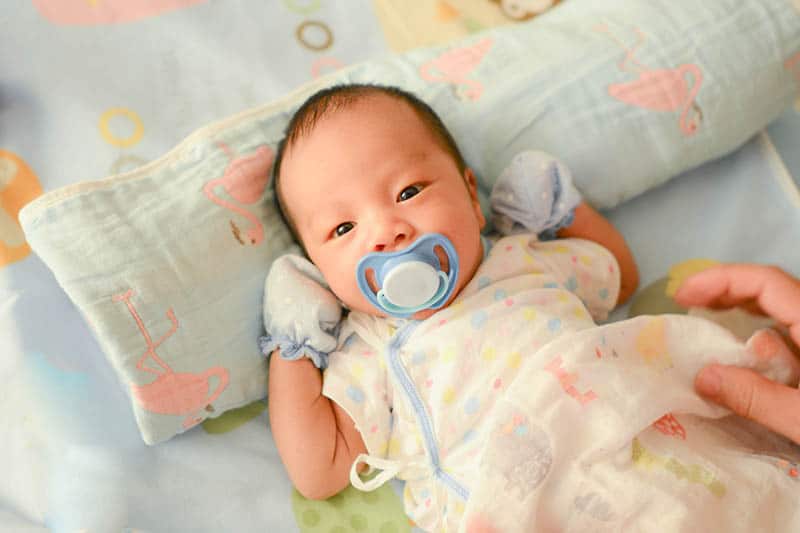
Keeping your baby’s oral development progressing at a solid pace is very important for your little one.
You don’t want any ol’ pacifier that is made just to look like one and serve no other function.
No, you want something that is properly tested, free of any harmful materials, and something that your baby finds soft enough to nibble and suckle on as a replacement for the real thing when the real thing is not available.
I made that mistake during my first period of motherhood with my daughter.
Thankfully, a friend of mine pointed it out early and I have since begun watching what products I get for my kids and that they are something that will provide them the extra comfort that they deserve.
Plus, finding the right binky will help prevent nipple confusion and will, hopefully, reduce the amount of times your baby ends up crying.
Are pacifiers even good for my child?
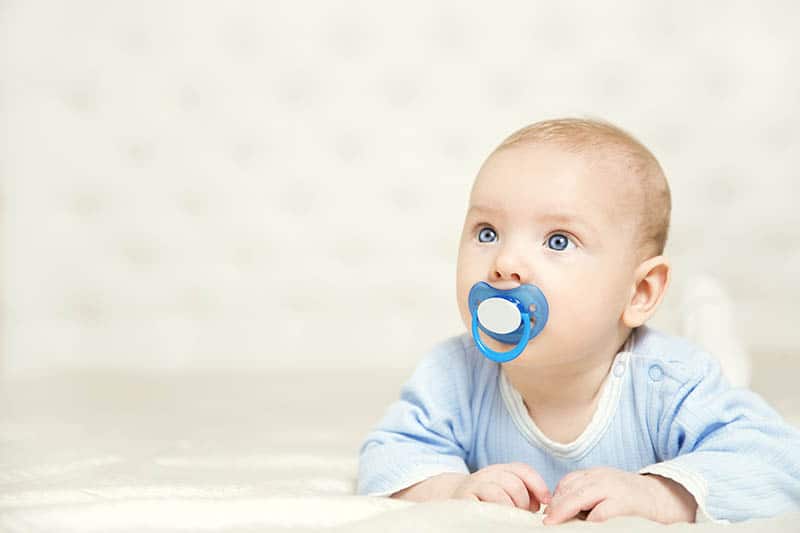
It is ultimately up to you to decide whether or not you should be getting one.
My honest advice is that the pros outweigh the cons and the right silicone pacifier, through proper pacifier use, will be a more positive experience for your child as well as ease your own workload.
The pros:
- Newborn pacifiers help the baby learn how to control their emotions on their own and soothe themselves – Sucking on something makes the baby feel calm and secure and at peace, helping you save those valuable hours of sleep at night.
- Pacifiers help satisfy the baby’s need to suck on something – This is a naturally occurring thing for any baby, even for other mammals. They have an innate need to suck and a mother’s breast or a bottle of milk will not always be there. Plus you don’t want them overeating. Providing them with a pacifier satisfies this need without resorting to giving them more food. Do make sure to not get them used to it though.
- Infant pacifiers help lower the risk of SIDS – Sudden infant death syndrome is a yet to be explained cause of death in young babies. While rare, it does still sometimes occur, mostly because babies’ young brains can sometimes forget to breathe during sleep. It is a sad fact, but a very present one, and a pacifier during naptime seems to help reduce the chances somewhat as it gives them a set pace to unconsciously follow when breathing, either through the baby’s nose or it’s mouth.
- A safe way of teething – Always present when the baby’s teeth start coming in and they want something to nibble on. A pacifier that doubles as a teether is generally the safest solution. Just make sure to replace it as soon as it gets damaged.
- A temporary distraction for the child – When you have to get the baby to the doctor’s office for vaccinations, check-ups, or any other procedures, a pacifier can help distract them from whatever thing they deem scary at the time. When my son was very young, he used to be deathly afraid of needles (still is, but that’s normal) so when he needed to get his shots, I always made sure to use a colorful pacifier to occupy his attention and he didn’t even notice the needle go in!
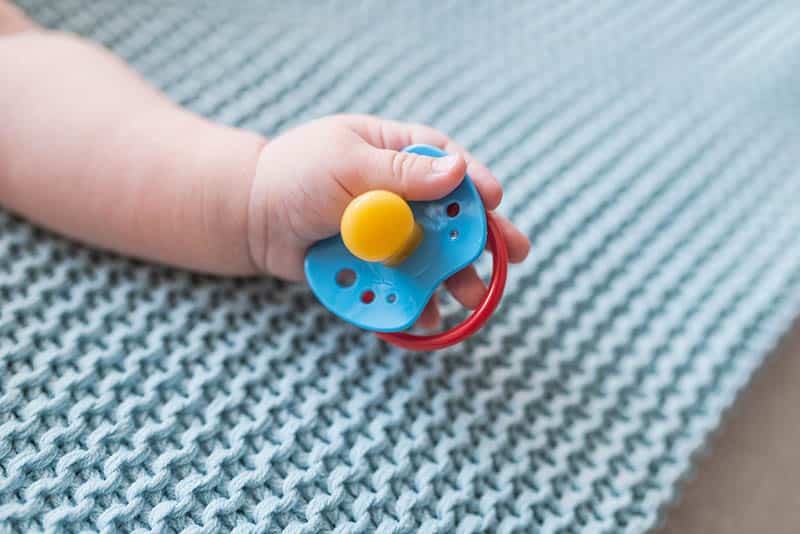
The cons:
- Babies might get used to the pacifier and become dependant on it. – Try to not let this happen. It can sometimes be a really tough habit to break and having the baby wake up multiple times in the middle of the night just because their binky fell out will become really stressful. Not only that, but they might start preferring the pacifier over their mother’s breast, which causes a whole other problem. To avoid this, do not give pacifiers to your breastfeeding babies until they are at least 3-4 weeks old, so they can get used to their mother’s touch first.
- Using pacifiers may lead to an increased chance of a middle ear infection – This is an odd claim but is apparently true, though it seems to be most prevalent during the period when SIDS is more likely to occur (between 0-6 months old), so it is really up to you whether or not you want to use one in this case.
- Overuse of pacifiers might lead to a number of problems regarding teeth – This is mostly the case if the child is still using a pacifier after their permanent teeth start coming in, but even before that it might cause them to grow in odd ways and not align properly. As I mentioned, one of my gaffs in my early days as a mother with my daughter was that I used any old pacifier I could find on store shelves and I didn’t regulate pacifier use, so my daughter’s first teeth started coming in a bit misshapen. This led to the need for braces now that she is older and that is on me for not paying enough attention.
- Pacifier clips can be very dangerous if not handled properly – There is nothing worse than fearing for your child’s life when using a pacifier clip that is too long and carries the risk of wrapping around your precious baby’s neck. Make sure the clip is short or don’t use one at all. Thankfully I haven’t had to deal with such a scare, but I have read about such dreadful stories happening due to a lack of attention for the baby and leaving them alone with such a potentially dangerous object.
What to look for in a pacifier
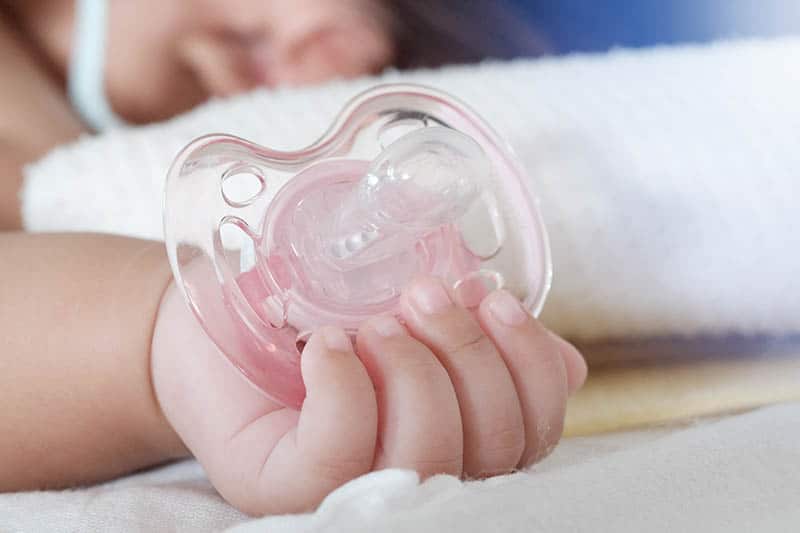
Not all are mandatory, but the more of these you can get on a pacifier, the better it is as a product.
I’ve started doing this after realizing how much harm not checking the quality of a product can do to my child.
1. Silicone > Latex
A silicone nipple is generally preferred over a latex one due to it being more durable than the latter, plus they are easier to clean and don’t absorb any pesky odors.
That said, silicone is less flexible than latex and might not be agreeable to your baby, though you might not be able to escape it if your child has an allergy to latex, which is why it’s always better to be safe than sorry.
2. A pacifier shield with ventilation holes
Another very important factor to consider is getting a pacifier with a shield that has holes in it.
This is to prevent the caking of drool around the baby’s mouth and reduce skin irritation by allowing the area around the pacifier to ‘breathe’ easier.
Pacifiers that don’t come with proper holes tend to be more cumbersome for the baby and they tend to be spat out more often since toddlers just want to catch their breath.
In my case, this was, again, something that I did not pay attention to in my early days and consequently I wondered why my daughter won’t take pacifier until other mothers with more experience explained the importance of a proper pacifier to me, and now I’m trying to do the same for all of you.
3. Get an orthodontic pacifier
Why orthodontic?
While yes, it does sound like just some snazzy new trend word, but getting a silicone orthodontic pacifier with an orthodontic nipple is something I recommend because it keeps your child’s bottom and top jaws in the correct position during pacifier use, alleviating any strain on either of them and letting your baby’s face develop in a proper, natural manner.
I didn’t do this and it is something I terribly regret not getting earlier for my daughter because a lot of money has gone toward braces and I’m not the one ‘suffering’ the most.
Thankfully I haven’t repeated the same mistake with my son.

4. BPA Free
BPA or Bisphenol A is a chemical most commonly mixed with other compounds to create high-grade plastic.
But, as it turns out, it seems to have quite the negative effect on humans, especially babies (girls even more so than boys due to it’s estrogen-like appearance).
It’s often found in the pacifier nipple and can cause children to develop hormonal issues, asthma, and fertility problems in later life.
Some even link it to increased chances of developing type-2 diabetes or various forms of cancer linked to hormonal glands.
This also goes for all of you fellow women who are expecting or are planning to have a child. Try avoiding BPA as much as you can, but that is a topic for another time.
5. Dishwasher safe
While being one of the least relevant pluses, it can still make life easier for any parent if the pacifier is dishwasher safe.
Reducing the amount of wasted water and allowing for quick and easy use right after a cleaning is a godsend.
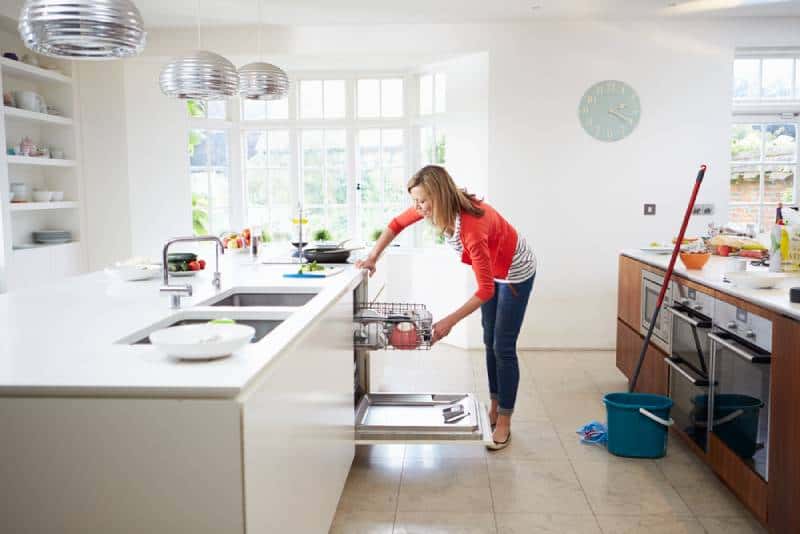
6. Make sure it’s a one-piece construction
Why? This ties into the dishwashing merit as if it is one-piece it means it won’t separate during a wash, plus it will not pose a choking hazard to your baby unlike their multi-part counterparts.
Plus, this is the standard for most pacifiers nowadays as stated in the American Academy of Pediatrics’ guidelines.
Imagine having to buy a whole new pacifier or parts of one just because a piece had gotten mysteriously lost or has fallen off during a daily stroll with your baby.
It’s not even just the health benefits, it’s even an issue of cost and practicality.
What to avoid
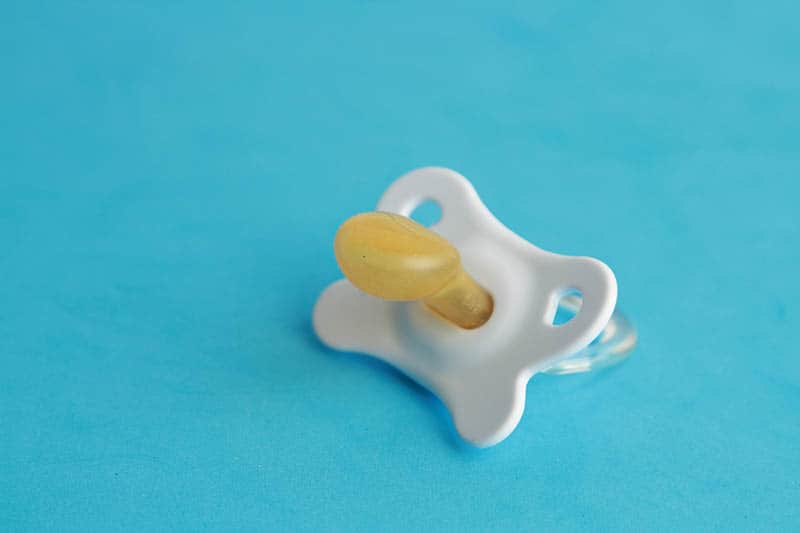
1. Latex
While not the biggest offender on this list, it can still be a hazard to your child if they have latex allergies, as these can get pretty nasty and you wouldn’t want to find that out by sheer accident.
So make sure to always look for latex-free pacifiers if you can help it.
I’ve known mothers have had issues with this when their babies developed rashes around the lips and across the skin where the latex would touch the baby.
It was quite unpleasant to deal with and I cannot imagine risking the same for my kids.
2. Phthalates
Phthalates are a group of chemicals that make plastic more flexible.
While lots of said chemicals fall into the category, several of them are allegedly linked to a number of health issues like asthma, ADHD, and even going so far as to potentially damage some vital organs like the liver or the kidneys.
This is something parents should definitely be on the lookout for before exposing their newborns and even older babies to it.
3. BPA
Bisphenol-A is, as I mentioned earlier, a chemical that is usually mixed with others to make plastic more flexible, but it is also used in various canned goods to keep the metal from breaking and corroding.
The problem is that not all of it ends up bonding to the metal and small bits end up mixing with the food, thus it’s very hard to escape from, especially in the case of babies.
The best thing you can do is steer clear of any food in a can and stick to glass containers and check for any BPA-free pacifiers.
Even this seems like it isn’t the ideal solution, since it seems that the tag just means it doesn’t have Bisphenol A, but instead it may have some other version of it (Bisphenol-S) instead.
While less harmful, it is still a potential danger, so keep an eye out, parents.
What to do if your baby doesn’t like pacifiers
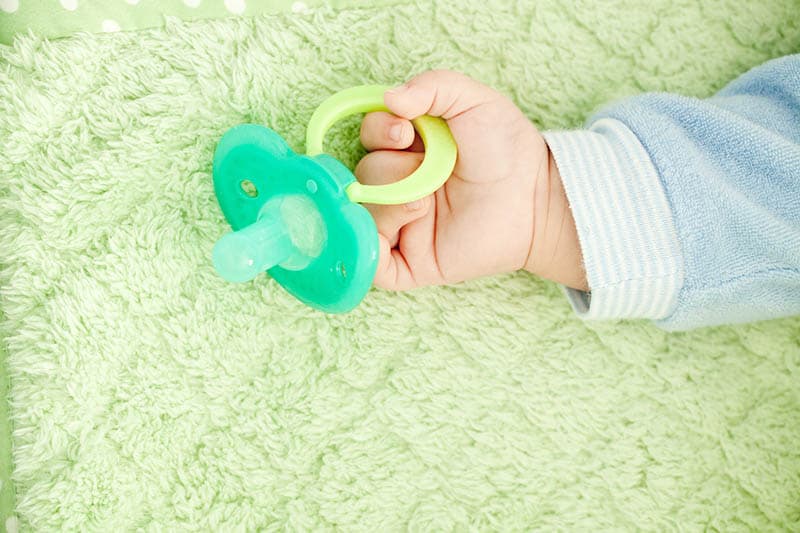
However, that might be a harder habit to break than just pulling a pacifier away from them when the time is right.
Plus, as previously stated, pacifiers do somehow end up aiding in preventing sudden infant death syndrome.
In the end, it is up to the baby to decide which kind of pacifier they like best and it is up to you to help them in finding their own perfect fit.
I hope I have helped you somewhat in this search and that parenthood is a joyous and fruitful period of your life.
Like this post? Please share or pin it for later. You can also stay in the loop and follow us on Facebook, Instagram or Pinterest.

We love honesty! Find Your Mom Tribe is an Amazon Associate and we earn from qualifying purchases through affiliate links at no extra cost to you. Please see our full Amazon Affiliate disclosure for more information.


